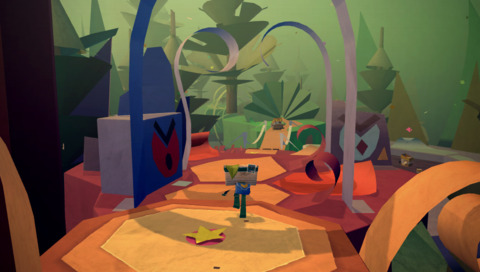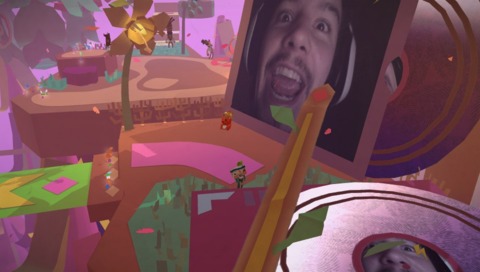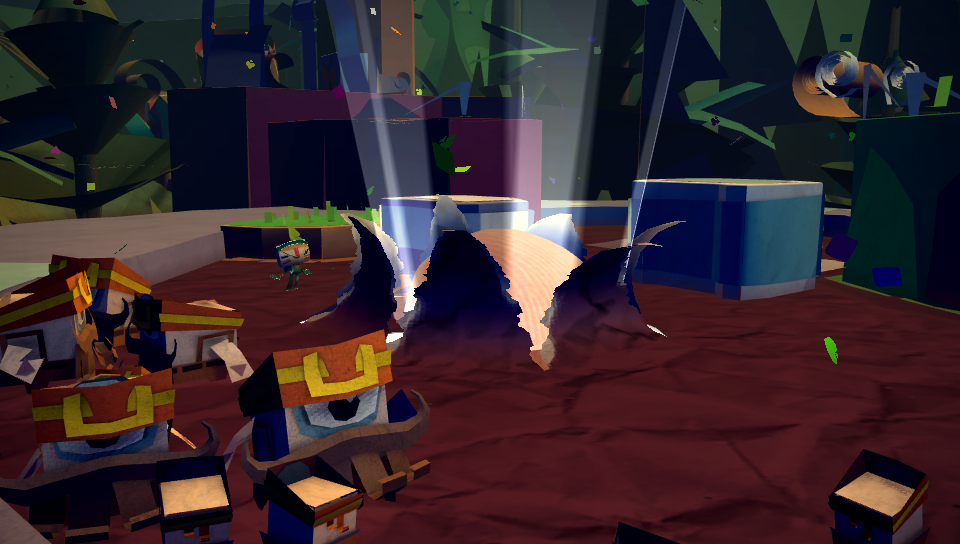It's difficult to write about Tearaway without talking about the Vita. The two are deeply intertwined. Tearaway could not exist without the Vita. The game acts as a testament to what might have been possible for a device in a parallel universe, one where it sold better and wasn't being refitted as an accessory to the PlayStation 4. It underscores what's possible when a developer views hardware features as potential, rather than marking a check box. Tearaway is a triumph for the Vita, validation of its design, even if we'll likely never get another game like it. One might be enough, especially for a game this delightful.

Tearaway is a world of paper, sliced and diced. Most of us can remember sitting in class rooms or summer camps, cutting up colored paper to try and bring our imaginations to life. If we saw those creations now, we would laugh. But at the time, they were incredible--real! Tearaway's world feels like the places we were trying to build, except now it's actually in front of us. Everything around you in Tearaway is playful, bouncing and hopping around, looking for your attention at every turn. Hey! Hi! Come here! You're the center of the unviverse in Tearaway, and only you can guide the game's hero, Iota, to safety. The story will turn at the drop of the hat, yet it never feels fake. It resembles a bedtime story, one a parent might be continually making up on the fly, simply because you didn't want it to end.
Gimmicks are only gimmicks if they aren't put to use. Technological gimmicks are common to video games. Sometimes they work out, often they don't. Nintendo characterized the rare instance where the raw potential of an idea, motion imbued in a controller, was perfectly realized in its first piece of software, Wii Sports. Nintendo never found a better use for motion controls after that. Sony's guilty, too. Developers tried their best to find reasons for tilting a Dual Shock 3 in a game, but it's mostly remembered for frustratingly walking across a log in Uncharted. Vita seemed liked it was chock full of these gimmicks: rear touch pad, tilt, cameras on the front and back. Rather than viewing these features as a burden, Media Molecule seemed to view it as a challenge. Rather than forcing these features onto an existing game idea, Tearaway feels like a game that was designed specifically to take advantage of every piece.
Along the way, Tearaway makes you feel deeply involved in Iota's quest, and I don't mean emotionally. You are quite literally involved, and this has everything to do with how the game takes into account what's unique on the Vita. You, the player, are constantly featured as the sun in the sky, and the camera will flip on to remind you of that fact. When put on the spot, you can make whatever face you want, it doesn't matter, but it's a constant reminder that Iota is not alone, and you are with him. The game will ask you take pictures of yourself to become part of the environment, or take snaps of what's around you, possibly to generate a texture for a moose seeking a new look. It's an interesting and effective way to ask passive players to be "creative" without demanding very much effort, and it makes the world uniquely yours.

This extends past aesthetic customization, and into the primary mechanics, such as rubbing your fingers on the rear touch to have fingers pop into the world (you can even customize skin color!) and flicking objects on the primary screen to reveal hidden platforms and rooms. Though Tearaway is a game you're playing on a handheld system, it feels alive and tangible in a way games usually aren't, since you are constantly physically interacting with the Vita beyond tapping X or O.
The game breaks the fourth wall in other crazy ways, too. There's an in-game camera system, one clearly inspired by Instagram. These photos do not exclusively live in the game, and can easily be shared on Twitter and elsewhere. One of Tearaway's collectibles involves snapping photos, which unlock papercraft models players can download, print out, and make on their own.
But all this love for Tearaway's effective use of the Vita could have been pretty easily undermined. Tearaway is a platformer from Media Molecule, and if you're like me, that might make you inclined to give the game a worrisome look. LittleBigPlanet was charming as hell, but a good platformer it was not. I couldn't stand the physics, even if I was enthralled by the aesthetic and soundtrack. Tearaway does not suffer the same fate. That's not accomplished by trying to compete with Mario, but embracing the quirk and charm that define Media Molecule's sense of humor, and imbuing that into the game design.
There is actually very little platforming involved with Tearaway, and the few times where the levels demand precision is when the game's at its weakest. You have some control over the camera with the right stick, but it's not consistent, and the instances where you can't seem to spin it around always felt like the points where the game is asking you to bop from one point to the next. The most frustrating moments in Tearaway are when the jumps look remarkably simple, and the camera won't let you pull it off.

These bits are few and far between, however. Tearaway leans on our ingrained desire to poke and prod at the worlds created for us, and find what has been hidden away. It's slightly unfair for Super Mario 3D World to have been released on the same day as Tearaway, a game that empitomizes the balance between encouraging players to explore and making sure the exploration itself is fun, not just the reward of a dancing collectible. In this, Tearaway works as often as it doesn't, with the game struggling to decide whether its world is compelling enough to entice players to look around, or whether collectibles are needed to make them stick around. Tearaway works best when its collectibles are tied to making use of the Vita itself in unique ways, particularly the blank papercraft models littered through each stage. To fill the papercraft in, players must point their camera and usher them into the world, and each time is as satisfying as the last. Even though they are, by definition, a collectible, it doesn't feel that way. Instead, it's about completing this lovely, living world surrounding you. It's far less fun when you're missing one, solitary piece of confetti, and it's seemingly nowhere to be found. That just feels like work.
Tearaway does not last very long. We're talking five or six hours at most. But take a good look; it's worth it. The view is spectacular, and over at just the right time. Games can outstay their welcome, and the best leave us wanting more, wishing to see one more stage. Tearway is a video game that happens to be about video games, as well. It's about you, the player, and it's about the people who make them, too. To say much more would unravel the touching, passionate message behind Tearaway, especially its remarkable ending, but the game leaves you in the same way it greets you: with a smile.